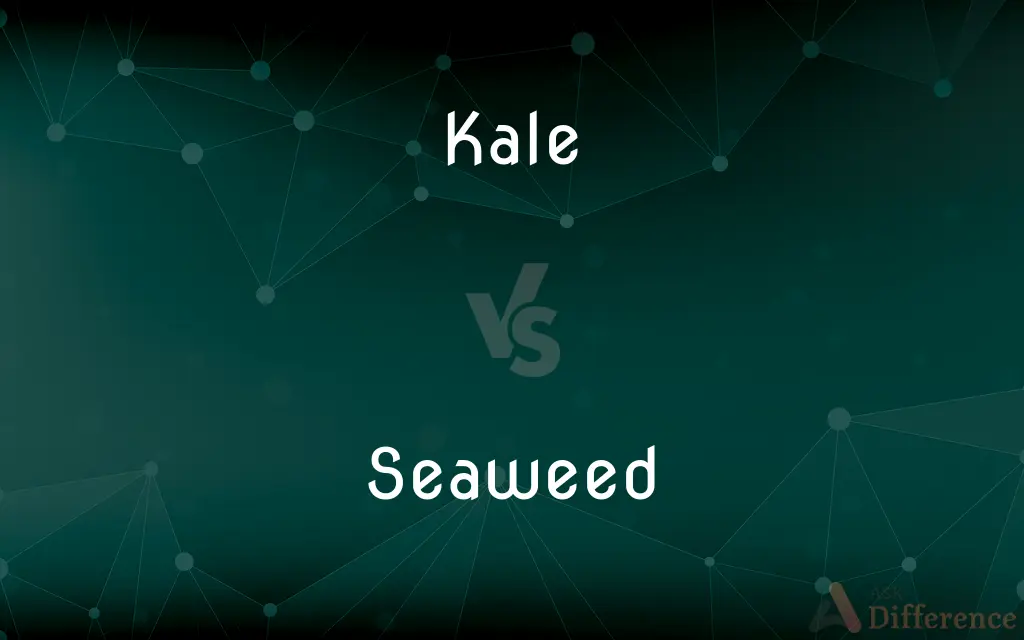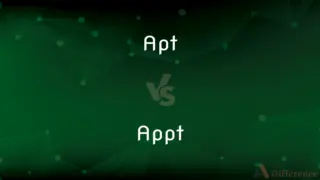Kale vs. Seaweed — What's the Difference?
By Tayyaba Rehman — Updated on November 5, 2023
Kale is a leafy green vegetable grown on land, while seaweed is a marine algae harvested from the sea.

Difference Between Kale and Seaweed
Table of Contents
ADVERTISEMENT
Key Differences
Kale is a cruciferous vegetable known for its nutrient-dense leaves, grown worldwide in a variety of climates. Seaweed encompasses numerous species of marine algae, integral to aquatic ecosystems, and harvested for food and other uses. Both are celebrated for their health benefits and versatility in cooking, but kale is typically used in fresh salads, smoothies, and as a cooked green, while seaweed is often found in Asian cuisine, supplements, and skincare products.
With its robust, earthy flavor, kale can be prepared in countless ways from chips to stews. Seaweed, with its distinct umami taste, is a common ingredient in sushi, soups, and snacks. Kale’s culinary versatility spans raw and cooked preparations, while seaweed is often consumed dried or reconstituted. Nutritionally, kale is high in fiber, vitamins A, K, C, and minerals like calcium and iron, whereas seaweed is a rare natural source of iodine, essential for thyroid function, and also provides a range of minerals and vitamins.
Kale is a hardy plant that thrives in cooler temperatures and can be easily cultivated in home gardens. In contrast, seaweed grows in marine environments, requiring specific harvesting methods that often involve sustainable aquaculture. Environmental impact considerations also distinguish the two; kale farming may involve standard agricultural issues such as pesticide use and water consumption, while seaweed farming is lauded for its minimal environmental impact and even positive effects on water quality.
The adaptability of kale allows it to be a staple in many traditional and modern dishes across various cuisines. Seaweed, despite its growing popularity, is still most closely associated with Asian cultures and cuisines. Both kale and seaweed have transcended culinary use, finding roles in health and wellness products; kale as a superfood ingredient in dietary supplements, and seaweed in a wide range of applications from thickening agents to skin care treatments.
Kale and seaweed represent the diversity of nutrient-rich foods available from both land and sea. While kale is part of the Brassica family of plants, seaweed is part of a vast and varied group of marine plants, including kelp and nori. Their differences in habitat and culinary application are vast, yet both provide substantial health benefits and have garnered popularity in health-conscious communities.
ADVERTISEMENT
Comparison Chart
Environment
Grown on land.
Harvested from the sea.
Classification
Leafy green vegetable.
Marine algae.
Taste
Earthy, slightly bitter.
Salty, umami.
Culinary Use
Salads, smoothies, cooked.
Sushi, soups, snacks.
Nutritional Content
High in vitamins A, K, C.
High in iodine, vitamins, minerals.
Cultivation
Farmed agriculturally.
Grown aquatically, often wild-harvested.
Cuisine
Global, diverse dishes.
Primarily Asian dishes.
Compare with Definitions
Kale
A nutritious leafy green vegetable
She added kale to her smoothie for an extra health boost.
Seaweed
A source of iodine and nutrients
She takes a seaweed supplement for her daily minerals.
Kale
A hardy garden vegetable
Their garden was full of kale, thriving in the cool weather.
Seaweed
Aquatic algae harvested for food
Dried seaweed is a staple in his pantry for Asian recipes.
Kale
A staple in health-conscious diets
He included kale in his salad for its high vitamin content.
Seaweed
Used in beauty products for skin health
Her favorite facial mask contains seaweed for its nourishing properties.
Kale
A plant from the cabbage family
Kale can survive frost, making it a great winter crop.
Seaweed
Seaweed, or macroalgae, refers to thousands of species of macroscopic, multicellular, marine algae. The term includes some types of Rhodophyta (red), Phaeophyta (brown) and Chlorophyta (green) macroalgae.
Kale
A versatile cooking ingredient
Kale chips are a delicious and crunchy snack.
Seaweed
Large algae growing in the sea or on rocks below the high-water mark
Seaweed glistened on the rocks
Seaweeds abound on most shores
Kale
Kale (), or leaf cabbage, belongs to a group of cabbage (Brassica oleracea) cultivars grown for their edible leaves, although some are used as ornamentals. Kale plants have green or purple leaves, and the central leaves do not form a head (as with headed cabbage).
Seaweed
Any of numerous marine algae, such as a kelp, rockweed, or gulfweed.
Kale
A hardy cabbage of a variety which produces erect stems with large leaves and no compact head.
Seaweed
A mass of such algae.
Kale
Money.
Seaweed
Any of numerous marine plants and algae, such as a kelp.
Kale
A plant (Brassica oleracea var. acephala) in the mustard family, having dark green, spreading, usually crinkled leaves that are eaten as a vegetable. Also called borecole, cole, colewort.
Seaweed
(by extension) Any of various fresh water plants and algae.
Kale
(Slang) Money.
Seaweed
Popularly, any plant or plants growing in the sea.
Kale
An edible plant, similar to cabbage, with curled leaves that do not form a dense head (Brassica oleracea var. acephala)
Seaweed
Any marine plant of the class Algæ, as kelp, dulse, Fucus, Ulva, etc.
Kale
Any of several cabbage-like food plants that are kinds of Brassica oleracea.
Seaweed
Plant growing in the sea, especially marine algae
Kale
(cooking) Broth containing kale as a chief ingredient.
Seaweed
An edible marine plant
Seaweed is commonly used in making sushi rolls.
Kale
Money.
Seaweed
A natural thickener in foods
Seaweed extract is used as a stabilizer in ice cream.
Kale
A variety of cabbage in which the leaves do not form a head, being nearly the original or wild form of the species.
Kale
See Kail, 2.
Kale
Informal terms for money
Kale
A hardy cabbage with coarse curly leaves that do not form a head
Kale
Coarse curly-leafed cabbage
Common Curiosities
Can kale and seaweed be eaten raw?
Kale can be eaten raw in salads, while some seaweed can be eaten raw but is usually dried or processed.
Are kale and seaweed gluten-free?
Yes, both are naturally gluten-free.
Are kale and seaweed suitable for vegans?
Yes, both are vegan-friendly.
Is organic kale or seaweed better?
Organic may have less pesticide use, but the best choice depends on personal preference and environmental factors.
Can you substitute kale for seaweed in recipes?
They have different flavors and textures, so they are not direct substitutes.
Is kale or seaweed better for weight loss?
Both are low in calories and can be part of a weight loss diet.
Are kale and seaweed available all year round?
Kale is seasonally grown, but often available year-round; seaweed is usually available year-round in dried form.
Can kale and seaweed be part of a low-carb diet?
Yes, they are both low in carbs.
Can you grow kale or seaweed at home?
Kale can be grown in gardens; seaweed typically requires a marine environment.
Do kale and seaweed contain protein?
Both contain some protein, with seaweed having a higher content by dry weight.
How do you store kale and seaweed?
Kale is best stored in the fridge; dried seaweed should be kept in a cool, dry place.
How do kale and seaweed impact the environment?
Kale farming uses land resources, while seaweed farming is considered environmentally friendly.
Can both kale and seaweed be used in smoothies?
Kale is common in smoothies, while seaweed is less typical but can be used in powdered form.
Are there different types of kale and seaweed?
Yes, there are several varieties of each.
Can kale and seaweed cause allergies?
Allergies are rare but possible for both.
Share Your Discovery

Previous Comparison
Abjure vs. Adjure
Next Comparison
Apt vs. ApptAuthor Spotlight
Written by
Tayyaba RehmanTayyaba Rehman is a distinguished writer, currently serving as a primary contributor to askdifference.com. As a researcher in semantics and etymology, Tayyaba's passion for the complexity of languages and their distinctions has found a perfect home on the platform. Tayyaba delves into the intricacies of language, distinguishing between commonly confused words and phrases, thereby providing clarity for readers worldwide.















































